Community Integrated Energy System Multi-Energy Transaction Decision Considering User Interaction
Abstract
:1. Introduction
2. Models of Community Integrated Energy Systems and User Interactions
2.1. CIES Model Based on Energy Hub
2.2. The Models of User Interaction That Account for Energy Conversion
2.2.1. Convertible Load Model
2.2.2. Reducible Electrical Load Model
2.2.3. Transferable Electrical Load Model
2.2.4. Heat Load Model
3. Optimization Model of Multi-Energy Transaction Decision between the Community Operator and the Users
3.1. Model Architecture of the Multi-Energy Transaction between the Community Operator and the Users Based on the Master–Slave Game
3.2. Pricing Model of Community Operator’s Retail Energy Prices
3.2.1. Objective Function
- (1)
- Energy retail income
- (2)
- Additional income for thermal comfort
- (3)
- Cost of purchasing energy
- (4)
- Cost of equipment operation and maintenance
- (5)
- Cost of renewable power abandonment
3.2.2. Multiple Energy Price Constraints
3.2.3. Energy Conversion Equipment Constraints
- (1)
- Combined heat and power unit
- (2)
- Gas boiler
- (3)
- Electric heat pump
3.2.4. Device Operation Constraints
- (1)
- Energy Conversion Equipment Constraints
- (2)
- Energy Storage Device Constraints
3.2.5. Renewable Energy Output Constraints
3.3. Energy Use Strategies Model Considering User Interaction
3.4. Model-Solving Process
- (1)
- Initialize the parameters of the community operator and the users, , set the maximum number of iterations , use the differential evolution algorithm to randomly generate retail energy prices of 10 groups of the community operator, and transmit them to the energy use strategies model considering user interaction.
- (2)
- .
- (3)
- The users receive retail energy prices published by the community operator. Use the CPLEX solver to solve the energy use strategies model and the optimal value-added benefit , and return the energy use strategies to the model of the community operator.
- (4)
- The community operator optimizes the output of equipment and the amount of electricity and gas purchased in the market according to the energy use strategies of the users and calculates the optimal profit of the community operator.
- (5)
- Use the variation and crossover of the differential evolution algorithm to generate a group of new retail energy prices and repeat the processes in (3) and (4). Additionally, calculate the optimal value-added benefit of the users and the optimal profit of the community operator under the new retail energy prices.
- (6)
- Perform selection operation: compare the optimal solutions of the community operator before and after mutation and crossover; if , then , ; if , then , .
- (6)
- If , end the program; otherwise, return to flow (2).
4. Case Analysis
4.1. Parameter Settings
4.2. Scene Settings
- Scenario 1: Regardless of user interaction [6], the energy price sold by the community operator to the users is the market price.
- Scenario 2: Considering user interaction [15] and ignoring the influence of the users’ electricity–gas convertible load, the community operator and the users compete to determine the electricity price and heat price of the community.
- Scenario 3: Considering user interaction, using the refined model of user interaction considering energy conversion and considering the impact of electricity–gas convertible load, the community operator and the users play games to formulate the internal electricity price and heat price in the community.
4.3. Simulation Analysis
4.3.1. Analysis of the Multi-Energy Transaction Results of the Community Operator
4.3.2. Analysis of Energy Use Strategies for User Interaction
4.3.3. Cost-Benefit Analysis of the Community Operator and Users
5. Conclusions
- (1)
- The retail energy prices of the community determined by the decision in this paper are reasonable and acceptable to the users. The average price of electricity and the average price of heat set by the community operator are 10.7% and 5.7% lower, respectively, than the market, which protects the interests of the users. The model is extensible. By modifying the corresponding model, more user groups can be promoted. For different countries and regions, the model of the upper community operator can be modified according to the actual situation, including the type of equipment and the type of renewable energy, which can be adjusted according to the needs. The lower user model can determine the types of user interaction load (including reducible, transferable, transferable, etc.) according to the living habits of residents in different countries and regions. At the same time, the lower model has variable data related to the users and can be applied to residential communities with different energy preferences.)
- (2)
- With the continuous improvement of the user side equipment, convertible load becomes possible. Users can choose appropriate energy modes to meet their energy needs according to different energy prices. The refined user interaction model that considers energy conversion constructed in this paper can reduce user costs.
- (3)
- The optimization model of the multi-energy transaction decision between the community operator and the users proposed in this paper considers the energy conversion on the user side, which can not only improve the profit of the community operator, but also increase the value-added benefit of energy use and realize a win–win situation for the community operator and the users. Using the strategy proposed in this paper to set the community prices increases the community operator’s profit and profit margin by 5.9% and 7.5%, respectively, compared to using market energy prices directly. At the same time, the value-added benefit to users also increases by 15.2%. In addition, user interaction can indirectly reduce the peak value of the grid, which is beneficial to grid security.
Author Contributions
Funding
Institutional Review Board Statement
Informed Consent Statement
Data Availability Statement
Conflicts of Interest
Appendix A
| Equipment | Parameter Type | Parameter Value |
|---|---|---|
| CHP | Rated Capacity | 300 kW |
| Minimum output power | 100 kW | |
| Electrical efficiency fitting coefficient | ||
| Thermoelectric ratio fitting coefficient | ||
| Operation and maintenance cost | 0.04 RMB/(kWh) | |
| EHP | Rated Capacity | 200 kW |
| Thermal efficiency fitting coefficient | ||
| Operation and maintenance cost | 0.06 RMB/kWh | |
| GB | Rated Capacity | 1000 kW |
| Thermal efficiency fitting coefficient | ||
| Operation and maintenance cost | 0.02 RMB/kWh | |
| Electricity storage | Rated Capacity | 500 kW |
| Charge/Discharge efficiency | 0.98 | |
| Attrition rate | 0.02 | |
| Operation and maintenance cost | 0.01 RMB/kWh | |
| Heat storage | Rated Capacity | 500 kW |
| Charge/Discharge efficiency | 0.95 | |
| Attrition rate | 0.02 | |
| Operation and maintenance cost | 0.01 RMB/kWh |
| Parameter | Meaning | Value | Parameter | Meaning | Value |
|---|---|---|---|---|---|
| Dead threshold for electrical energy conversion | 0 | Saturation value of electrical energy conversion | 0.2 | ||
| Dead threshold for natural gas conversion | 0 | Saturation value of natural gas conversion | 0.15 | ||
| First power coefficient of electrical energy preference | 1.5 | Quadratic coefficient of electrical energy preference | 0.0009 | ||
| First power coefficient of thermal energy preference | 1.1 | Quadratic coefficient of thermal energy preference | 0.0011 | ||
| First power coefficient of natural gas preference | 1.2 | Quadratic coefficient of natural gas preference | 0.001 | ||
| Number of the users with adjustable heating temperature | 500 | Number of the users with non-adjustable heating temperature | 300 | ||
| Maximum load that can be transferred out | 80 kW | Maximum load that can be transferred in | 80 kW | ||
| Maximum duration of electrical load reduction | 4 h | The most comfortable indoor temperature | 22.6 °C |
| Period | Market Electricity Price (RMB/kWh) |
|---|---|
| Valley period: 01:00—07:00 | 0.35 |
| Normal period: 08:00—10:00; 15:00—17:00; 22:00—24:00 | 0.5 |
| Peak period: 11:00—14:00; 18:00—21:00 | 0.8 |

References
- Bai, L.; Li, F.; Cui, H.; Jiang, T.; Sun, H.; Zhu, J. Interval optimization based operating strategy for gas-electricity integrated energy systems considering demand response and wind uncertainty. Appl. Energy 2016, 167, 270–279. [Google Scholar] [CrossRef]
- Wang, L.; Hou, C.; Ye, B.; Wang, X.; Yin, C.; Cong, H. Optimal Operation Analysis of Integrated Community Energy System Considering the Uncertainty of Demand Response. IEEE Trans. Power Syst. 2021, 36, 3681–3691. [Google Scholar] [CrossRef]
- Gokcek, T.; Sengor, I.; Erdinc, O. A Novel Multi-Hierarchical Bidding Strategies for Peer-to-Peer Energy Trading among Communities. IEEE Access 2022, 10, 23798–23807. [Google Scholar] [CrossRef]
- Mediwaththe, C.P.; Stephens, E.R.; Smith, D.B.; Mahanti, A. Competitive Energy Trading Framework for Demand-Side Management in Neighborhood Area Networks. IEEE Trans. Smart Grid. 2018, 9, 4313–4322. [Google Scholar] [CrossRef]
- Li, J.; Tian, L.; Cheng, L.; Guo, J. Optimization Planning of Micro-energy System Considering the Characteristics of Variable Operating Conditions (1) Basic Model and Analysis. Autom. Electr. Power Syst. 2018, 42, 18–26+49. [Google Scholar]
- Chen, W.; Mu, Y.; Jia, H.; Wei, W.; He, W. Optimization Scheduling Method for Regional Integrated Energy System Considering Equipment Variable Operating Condition Characteristics. Power Syst. Technol. 2021, 45, 951–958. [Google Scholar]
- Wang, Y.; Ma, Y.; Song, F.; Ma, Y.; Qi, C.; Huang, F.; Xing, J.; Zhang, F. Economic and efficient multi-objective operation optimization of integrated energy system considering electro-thermal demand response. Energy 2020, 205, 118022. [Google Scholar] [CrossRef]
- Guo, Z.; Zhang, R.; Wang, L.; Zeng, S.; Li, Y. Optimal Operation of regional integrated energy system considering demand response. Appl. Therm. Eng. 2021, 191, 116860. [Google Scholar] [CrossRef]
- Liu, R.; Yang, T.; Sun, G.; Lin, S.; Muyeen, S.M.; Ma, T. Optimal Dispatch of Community Integrated Energy System Considering Comprehensive User Satisfaction Method. IEEJ Trans. Electr. Electron. Eng. 2022. [Google Scholar] [CrossRef]
- Miao, B.; Lin, J.; Li, H.; Liu, C.; Li, B.; Zhu, X.; Yang, J. Day-Ahead Energy Trading Strategies of Regional Integrated Energy System Considering Energy Cascade Utilization. IEEE Access 2020, 8, 138021–138035. [Google Scholar] [CrossRef]
- Li, Y.; Feng, C.; Wen, F.; Wang, K.; Huang, Y. Energy Pricing and Management of Park Energy Internet Including Electric Vehicles and Electricity-to-Gas Conversion. Autom. Electr. Power Syst. 2018, 42, 192–196. [Google Scholar]
- Wei, W.; Liu, F.; Mei, S. Energy Pricing and Dispatch for Smart Grid Retailers Under Demand Response and Market Price Uncertainty. IEEE Trans. Smart Grid. 2015, 6, 1364–1374. [Google Scholar] [CrossRef]
- Paudel, A.; Chaudhari, K.; Long, C.; Gooi, H.B. Peer-to-Peer Energy Trading in a Prosumer-Based Community Microgrid: A Game-Theoretic Model. IEEE Trans. Ind. Electron. 2019, 66, 6087–6097. [Google Scholar] [CrossRef]
- Ma, L.; Liu, N.; Zhang, J.; Wang, L. Real-Time Rolling Horizon Energy Management for the Energy-Hub-Coordinated Prosumer Community from a Cooperative Perspective. IEEE Trans. Power Syst. 2019, 34, 1227–1242. [Google Scholar] [CrossRef]
- Fu, Y.; Li, H. Energy Management and Pricing Strategy of Multi-energy Supply Service in Parks Considering User Utility Evaluation. Modern Electric Power. 2022, 39, 317–328. [Google Scholar]
- Fleischhacker, A.; Corinaldesi, C.; Lettner, G.; Auer, H.; Botterud, A. Stabilizing Energy Communities Through Energy Pricing or PV Expansion. IEEE Trans. Smart Grid. 2022, 13, 728–737. [Google Scholar] [CrossRef]
- Anoh, K.; Maharjan, S.; Ikpehai, A.; Zhang, Y.; Adebisi, B. Energy Peer-to-Peer Trading in Virtual Microgrids in Smart Grids: A Game-Theoretic Approach. IEEE Trans. Smart Grid. 2020, 11, 1264–1275. [Google Scholar] [CrossRef]
- Wei, F.; Jing, Z.X.; Wu, P.Z.; Wu, Q.H. A Stackelberg game approach for multiple energies trading in integrated energy systems. Appl. Energy 2017, 200, 315–329. [Google Scholar] [CrossRef]
- Li, P.; Wang, Z.; Wang, N.; Yang, W.; Li, M.; Zhou, X.; Yin, Y.; Wang, J.; Guo, T. Stochastic robust optimal operation of community integrated energy system based on integrated demand response. Int. J. Electr. Power Energy Syst. 2021, 128, 106735. [Google Scholar] [CrossRef]
- Ruan, W.; Wang, B.; Li, Y.; Yang, S. Research on User Response Behavior Under Peak and Valley Time-of-use Electricity Prices. Power Syst. Technol. 2012, 36, 86–93. [Google Scholar]
- Geidl, M.; Koeppel, G.; Favre-Perrod, P.; Klockl, B.; Andersson, G.; Frohlich, K. Energy hubs for the future. IEEE Power Energy Mag. 2007, 5, 24–30. [Google Scholar] [CrossRef]
- Wang, Y.; Zhang, N.; Kang, C.; Kirschen, D.S.; Yang, J.; Xia, Q. Standardized Matrix Modeling of Multiple Energy Systems. IEEE Trans. Smart Grid. 2019, 10, 257–270. [Google Scholar] [CrossRef]
- Cui, Y.; Guo, F.; Fu, X.; Zhao, Y.; Han, C. Coordinated and optimized source-charge dispatch of an integrated energy system that promotes wind power consumption through energy-supply conversion. Power Syst. Technol. 2022, 46, 1437–1447. [Google Scholar]
- Li, Y.; Zhang, Z.; Yang, L.; Tang, D.; Dong, C.; Ji, C. A Decision-making Model for Incremental Power Distribution and Sales Companies Considering Collaborative Optimization of Source, Load and Storage. Autom. Electr. Power Syst. 2021, 45, 125–132. [Google Scholar]
- Giannelos, S.; Konstantelos, I.; Strbac, G. Option Value of Demand-Side Response Schemes Under Decision-Dependent Uncertainty. IEEE Trans. Power Syst. 2018, 33, 5103–5113. [Google Scholar] [CrossRef]
- Wu, C.; Gu, W.; Xu, Y.; Jiang, P.; Lu, S.; Zhao, B. Bi-level optimization model for integrated energy system considering the thermal comfort of heat customers. Appl. Energy 2018, 232, 607–616. [Google Scholar] [CrossRef]
- Sun, Y.; Zhang, C.; Li, Z.; Zhang, X.; Li, F. Flexible Load Multi-power-level Regulation Strategies Considering multi-regional User Differentiated PMV. Proc. CSEE 2021, 41, 7574–7586. [Google Scholar]
- Mu, Y.; Chen, W.; Yu, X.; Jia, H.; Hou, K.; Wang, C.; Meng, X. A double-layer planning method for integrated community energy systems with varying energy conversion efficiencies. Appl. Energy 2020, 279, 115700. [Google Scholar] [CrossRef]
- Zhao, H.; Miao, S.; Li, C.; Zhang, D.; Tu, Q. Research on the Optimal Operation Strategies of the Integrated Energy System in the Park Considering the Coupled Response Characteristics of Cooling, Heating and Electricity Demand. Proc. CSEE 2022, 42, 573–589. [Google Scholar]
- Maharjan, S.; Zhu, Q.; Zhang, Y.; Gjessing, S.; Basar, T. Dependable Demand Response Management in the Smart Grid: A Stackelberg Game Approach. IEEE Trans. Smart Grid. 2013, 4, 120–132. [Google Scholar] [CrossRef]
- Liu, R.; Li, Y.; Yang, X.; Li, Y.; Sun, G.; Shi, S. Two-stage Optimal Scheduling of Community Integrated Energy System Considering Demand Response. Acta Energ. Sol. Sin. 2021, 42, 46–54. [Google Scholar]
- Li, L. Development and Problems of Residential Centralized Cooling (Heating) in Hefei. Anhui Archit. 2021, 28, 79–80. [Google Scholar]
- Zhao, Y.; Gao, H.; Wang, Z.; Zhang, R.; Zhong, L.; Li, Y.; Liu, J. Optimization Decision of Multi-energy Trading Game for Business Park Operators Considering User Power Substitution. Power Syst. Technol. 2021, 45, 1320–1331. [Google Scholar]
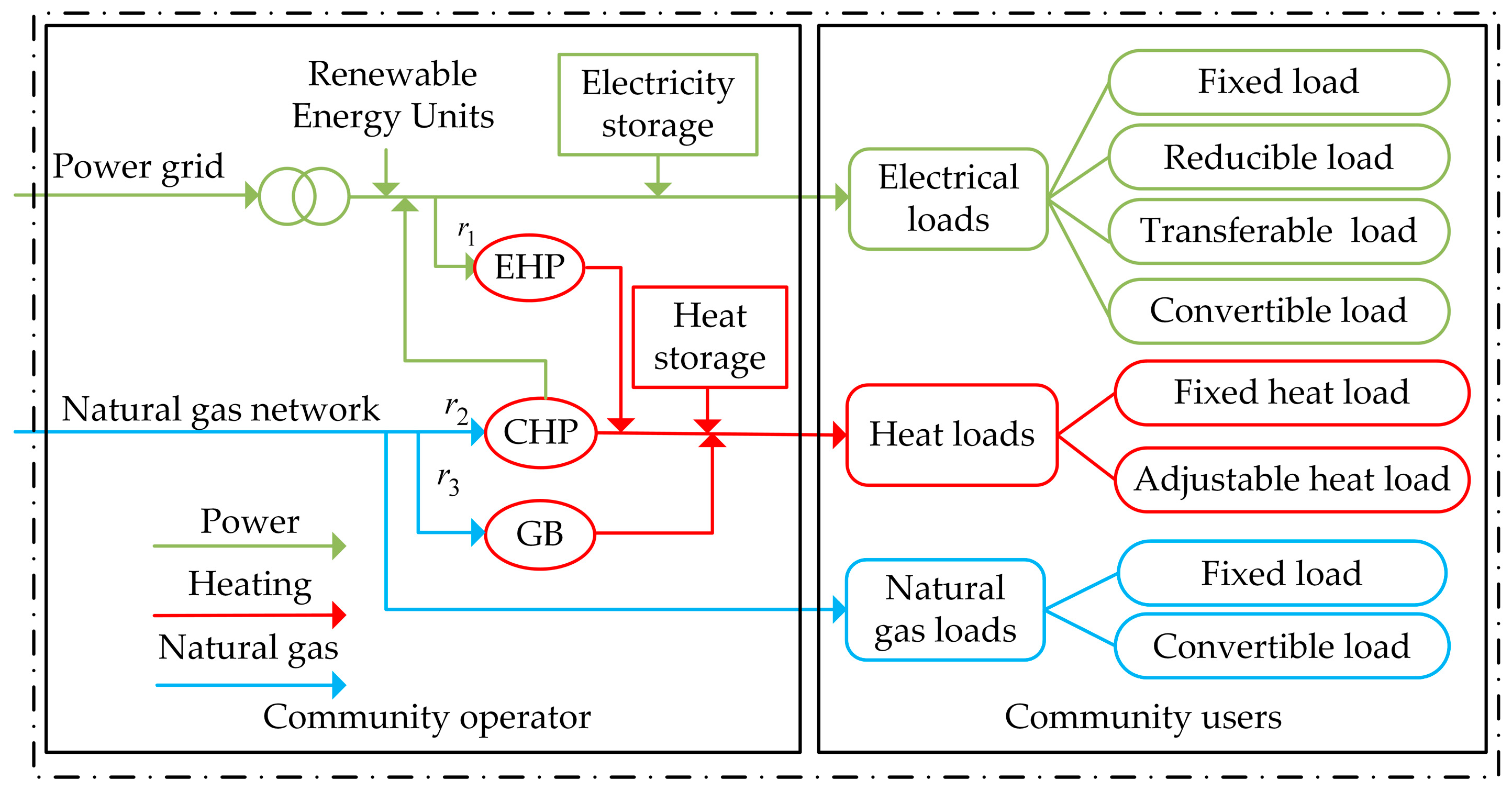
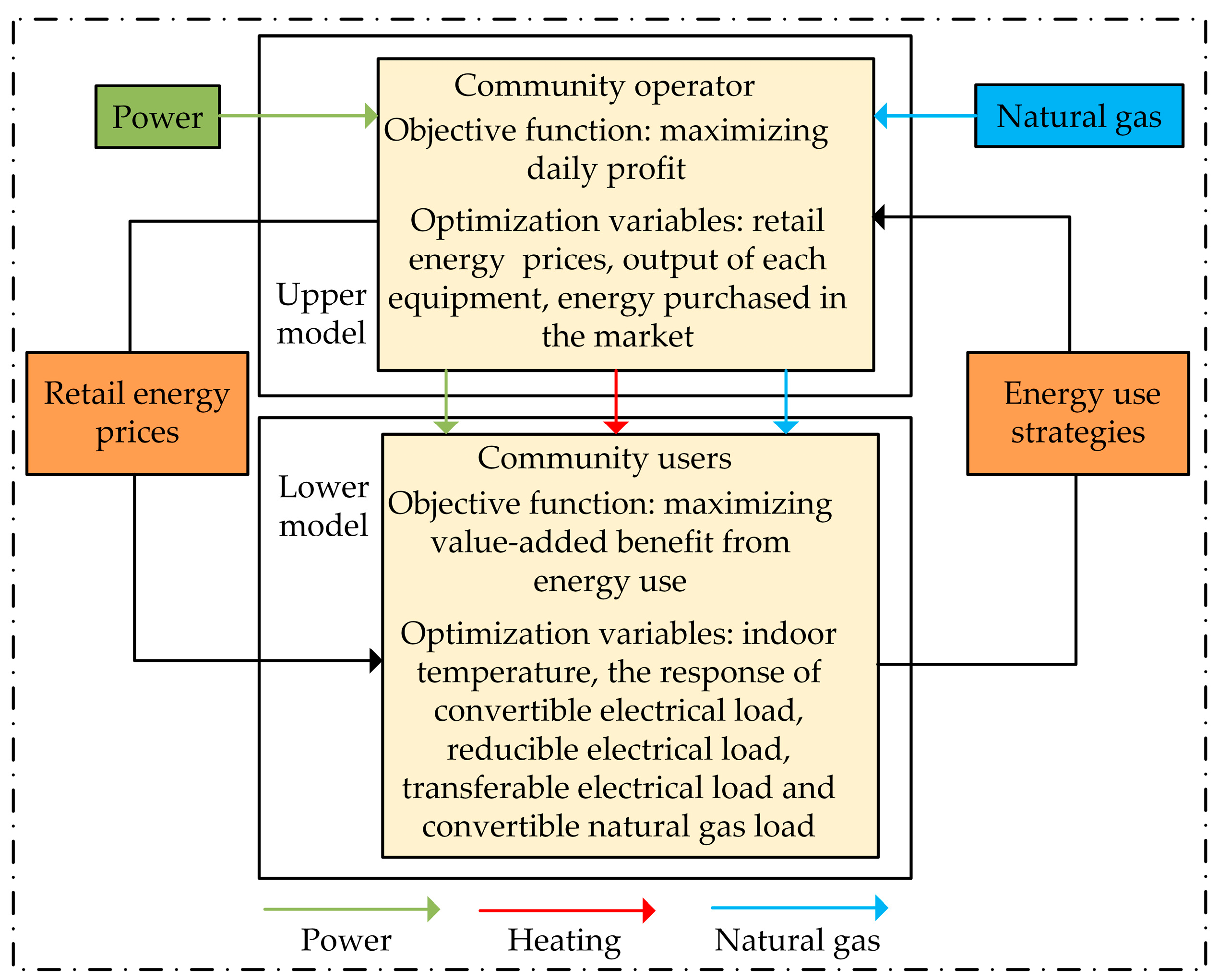
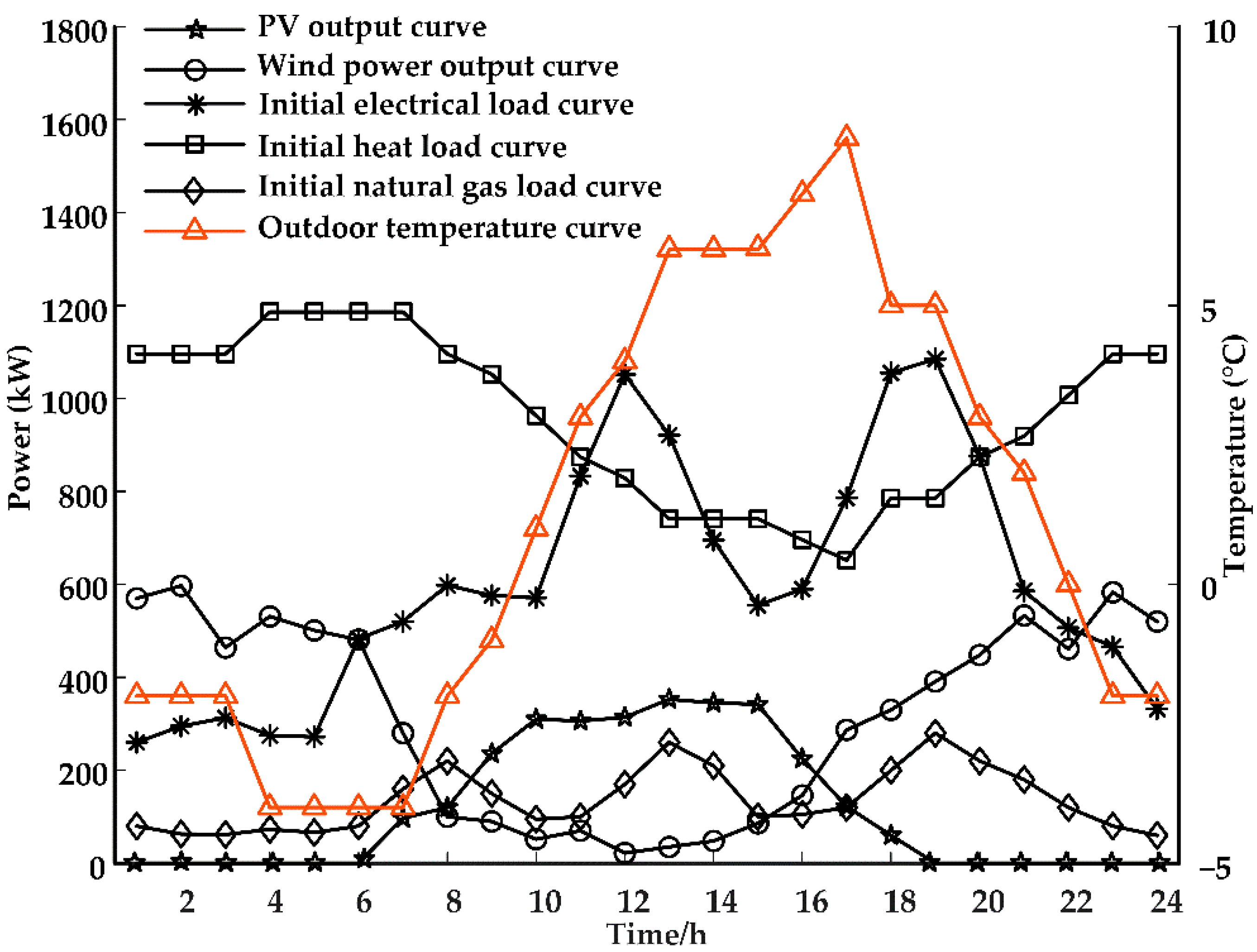

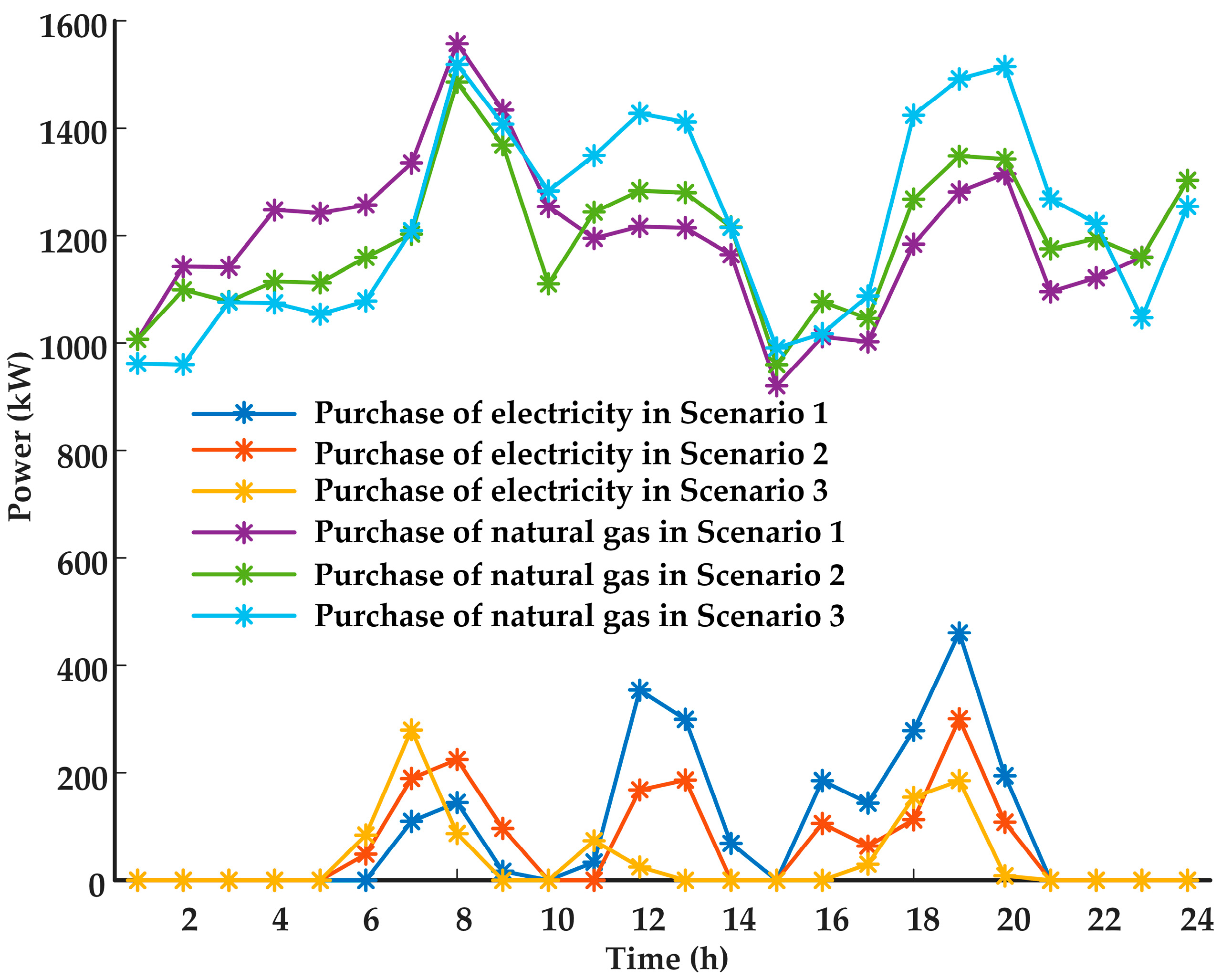

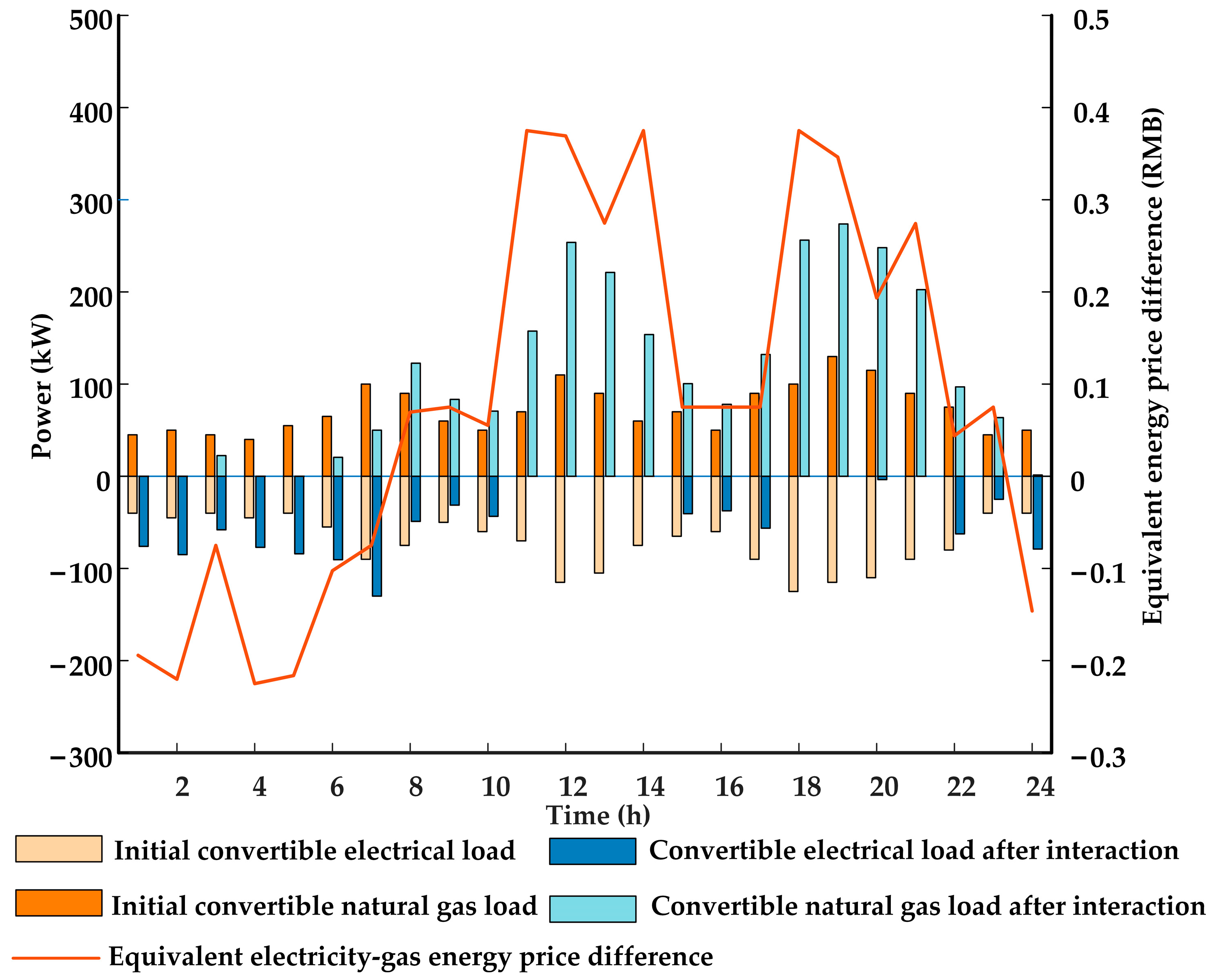

| Compare Items | Scenario 1 | Scenario 2 | Scenario 3 | |
|---|---|---|---|---|
| Community operator | Cost (RMB) | 13,940 | 12,486 | 11,976 |
| Profit (RMB) | 4459 | 4329 | 4720 | |
| Profit margin (%) | 31.9 | 34.7 | 39.4 | |
| Renewable energy utilization (%) | 88 | 93 | 96 | |
| Community users | Total cost (RMB) | 18,399 | 16,815 | 16,690 |
| Value-added benefit | 15,121 | 16,993 | 17,412 | |
| Compare Items | Scenario 3 | Scenario 4 | |
|---|---|---|---|
| Community operator | Cost (RMB) | 11,976 | 13,153 |
| Profit (RMB) | 4720 | 4957 | |
| Profit margin (%) | 39.4 | 37.6 | |
| Community users | Total cost (RMB) | 16,690 | - |
| Value-added benefit | 17,412 | - | |
| The optimization method | The master–slave game | The centralized optimization | |
| Whether user interaction is considered | √ | √ | |
| Whether the convertible load is considered | √ | × | |
| Whether the retail energy prices have been optimized | √ | × | |
| Whether a win–win situation has been achieved | √ | × | |
Publisher’s Note: MDPI stays neutral with regard to jurisdictional claims in published maps and institutional affiliations. |
© 2022 by the authors. Licensee MDPI, Basel, Switzerland. This article is an open access article distributed under the terms and conditions of the Creative Commons Attribution (CC BY) license (https://creativecommons.org/licenses/by/4.0/).
Share and Cite
Li, Y.; Wang, X. Community Integrated Energy System Multi-Energy Transaction Decision Considering User Interaction. Processes 2022, 10, 1794. https://doi.org/10.3390/pr10091794
Li Y, Wang X. Community Integrated Energy System Multi-Energy Transaction Decision Considering User Interaction. Processes. 2022; 10(9):1794. https://doi.org/10.3390/pr10091794
Chicago/Turabian StyleLi, Yuantian, and Xiaojing Wang. 2022. "Community Integrated Energy System Multi-Energy Transaction Decision Considering User Interaction" Processes 10, no. 9: 1794. https://doi.org/10.3390/pr10091794




